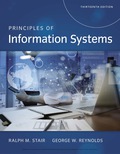
Concept explainers
Enterprise system (ERP):
An enterprise system is essential to individuals and organizations of all sizes and guarantees that information can be shared through all business functions and through all levels of management to maintain the running and managing of a business.
Customer Relationship Management (CRM):
A system that helps a company to manage all aspects of customer encounters, which includes marketing, sales, distribution, accounting and customer service.
- The objective of CRM is to recognize and anticipate the requirements of present and potential customers to raise customer holding and reliability, while enhancing the technique that products and services are retailed.
Product Lifecycle Management (PLM):
Product lifecycle management is an enterprise business policy that generates a common source of information about products and processes to maintain the combined creation, distribution, management, and use of product and packaging description information.
- PLM includes marketing and sales, research and progress, new development, product plan, model and testing, manufacturing process design, production and gathering, product delivery and installation process, maintenance and support, and stepping down and replacement of product.
Trending nowThis is a popular solution!

Chapter 8 Solutions
Principles of Information Systems (MindTap Course List)
- Node.js, Express, and Nunjucks Templates?arrow_forwardCIT244 Program Project 3 Assignment As with any assigned program, do not wait until the last minute to start. Start early in the week the program is due so you can ask questions if you get stuck Node.js and Express and Nunjucks Templates We have gotten to the good stuff. There is a program similar to this assignment given as the last example in the lecture notes for the week that discusses node static files. This program will take more time that previous assignments. There are several examples you should study first, particularly the pizza order example program available in the examples programs folder for the week discussing static files. You should study and run the pizza order program before trying this program. The pseudo-company is called Sun or Fun, which offers cheap flights from Louisville to either Miami or Vegas. Here's a video of how it should work. NOTE: You will hear or see references to Handlebars in this video. We used to use Handlebars, but it will be Nunjucks that we…arrow_forwardhow to write the expression for the outputarrow_forward
- Discussion 1. Comment on your results. 2. Compare between the practical and theoretical results. 3. Find VB, Vc on the figure below: 3V V₁₁ R₁ B IR, R, IR, R www ΙΚΩ www www I 1.5KQ 18₁ 82002 R₁ 3.3KQ R₂ 2.2KQ E Darrow_forwardAgile1. a. Describe it and how it differs from other SDLC approachesb. List and describe the two primary terms for the agile processc. What are the three activities in the Construction phasearrow_forwardhow are youarrow_forward
- need help with thi Next, you are going to combine everything you've learned about HTML and CSS to make a static site portfolio piece. The page should first introduce yourself. The content is up to you, but should include a variety of HTML elements, not just text. This should be followed by an online (HTML-ified) version of your CV (Resume). The following is a minimum list of requirements you should have across all your content: Both pages should start with a CSS reset (imported into your CSS, not included in your HTML) Semantic use of HTML5 sectioning elements for page structure A variety other semantic HTML elements Meaningful use of Grid, Flexbox and the Box Model as appropriate for different layout components A table An image Good use of CSS Custom Properties (variables) Non-trivial use of CSS animation Use of pseudeo elements An accessible colour palette Use of media queries The focus of this course is development, not design. However, being able to replicate a provided design…arrow_forwardUsing the notationarrow_forwardyou can select multipy optionsarrow_forwardarrow_back_iosSEE MORE QUESTIONSarrow_forward_ios
 Principles of Information Systems (MindTap Course...Computer ScienceISBN:9781305971776Author:Ralph Stair, George ReynoldsPublisher:Cengage Learning
Principles of Information Systems (MindTap Course...Computer ScienceISBN:9781305971776Author:Ralph Stair, George ReynoldsPublisher:Cengage Learning Fundamentals of Information SystemsComputer ScienceISBN:9781337097536Author:Ralph Stair, George ReynoldsPublisher:Cengage Learning
Fundamentals of Information SystemsComputer ScienceISBN:9781337097536Author:Ralph Stair, George ReynoldsPublisher:Cengage Learning Principles of Information Systems (MindTap Course...Computer ScienceISBN:9781285867168Author:Ralph Stair, George ReynoldsPublisher:Cengage Learning
Principles of Information Systems (MindTap Course...Computer ScienceISBN:9781285867168Author:Ralph Stair, George ReynoldsPublisher:Cengage Learning Fundamentals of Information SystemsComputer ScienceISBN:9781305082168Author:Ralph Stair, George ReynoldsPublisher:Cengage Learning
Fundamentals of Information SystemsComputer ScienceISBN:9781305082168Author:Ralph Stair, George ReynoldsPublisher:Cengage Learning Systems ArchitectureComputer ScienceISBN:9781305080195Author:Stephen D. BurdPublisher:Cengage Learning
Systems ArchitectureComputer ScienceISBN:9781305080195Author:Stephen D. BurdPublisher:Cengage Learning





